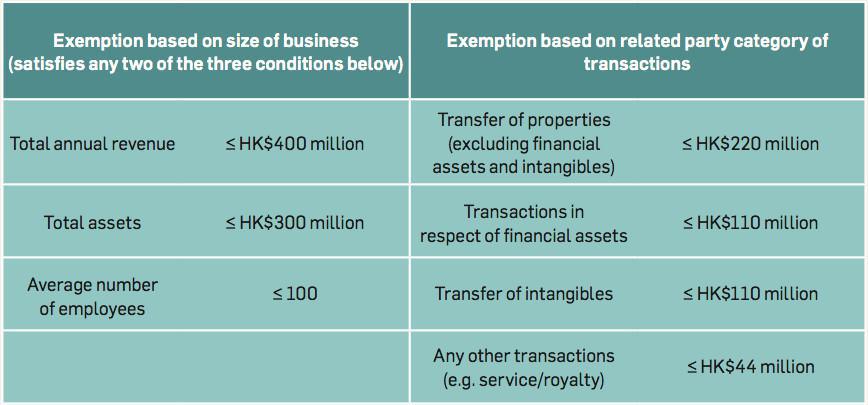- DIPN 58 – Transfer Pricing Documentation and Country-by-Country Reports
- DIPN 59 – Transfer Pricing between Associated Persons
- DIPN 60 – Attribution of Profits to Permanent Establishments in Hong Kong
Recap of the TP ordinance
The TP ordinance, a milestone in the Hong Kong tax regime, is the first piece of local legislation to explicitly address transfer pricing (TP) matters. The TP ordinance codifies the arm’s length principle of TP into the Inland Revenue Ordinance through two rules and documentation requirements.
TP rule 1: empowers the IRD to impose adjustments on either income or expenses arising from non-arm’s length transactions between associated persons that lead to a potential Hong Kong tax advantage. This rule is applicable retroactively to years of assessment (YOA) beginning on or after 1 April 2018.
TP rule 2: requires the use of the separate enterprises principle for attribution of profits to a permanent establishment (PE) of a non-Hong Kong resident in Hong Kong. TP rule 2 is applicable to YOA beginning on or after 1 April 2019.
Documentation: a mandatory three-tiered TP documentation requirement, consisting of master file, local file, and country-by-country (CbC) report, with certain exemption thresholds.
DIPN 58
In detail
DIPN 58 specifies the IRD’s views and practices on the three-tiered TP documentation requirement.
Master file and local file
1. Exemption threshold
The TP ordinance provides two types of exemptions to master and local file preparations to entities that engage in transactions with associated enterprises. Taxpayers are exempt if they meet either of the categories (see table below). DIPN 58 provides clarity on the applicability of the exemption thresholds.
a. Exemption based on size of business:
- “Total amount of revenue” refers to the aggregated amount of all types of revenue and income disclosed in the entity’s financial statements, which include revenue and income measured through other comprehensive income.
- “Total value of assets” refers to the aggregated amount of all types of assets, after amortization and depreciation, disclosed in the entity’s financial statements as of the balance sheet date and should not be net of any liabilities.
- “Average number of employees” is all full- and part-time staff and secondees who have worked for the entity and are considered to have an employer-employee relationship with the entity. This should be calculated as: the aggregate of the number of employees at the end of each month in the accounting period divided by the number of months in the accounting period.
b. Exemption based on amounts of controlled transactions:
- When determining whether the threshold is exceeded, the same type “arm’s length” transactions should be aggregated.
- Both the drawdown amount of a loan and the payment of interest should be included in the “transactions in respect of financial assets” category when assessing whether the threshold is exceeded.
- Grandfathered transactions (i.e. transactions entered into or effected before 13 July 2018) and specified domestic transactions can be disregarded in determining whether the threshold of controlled transactions is exceeded, and can be excluded in a local file.
- Transactions from which the income or profits are (or are claimed to be) sourced outside Hong Kong should still be included in the calculation of thresholds and should be covered in the local file.
2. Covered period
The master and local file requirements apply to accounting periods beginning on or after 1 April 2018. In cases where the accounting period of a Hong Kong entity differs from that of its ultimate parent entity (UPE), the Hong Kong entity should prepare its local file in respect of its own accounting period. Its master file should be prepared in respect of the period for which the whole group’s consolidated financial statements are prepared and which ends within the Hong Kong entity’s accounting period.
3. TP documentation and audit
The IRD expects taxpayers to retain relevant documentation to demonstrate that their TP treatment complies with the arm’s length principle. More importantly, taxpayers are expected to demonstrate that they have made reasonable efforts to determine the arm’s length amount. DIPN 58 emphasizes that keeping comprehensive TP documentation (including master file and local file) may lessen the likelihood of an audit and mitigate penalty exposure.
CbC report
1. Exemption thresholds for different UPEs of groups based on jurisdictions:
- Hong Kong tax resident: threshold amount is HK$6.8 billion.
- Tax resident in another jurisdiction which has implemented CbC report requirement: threshold amount would follow the amount stipulated in that jurisdiction’s laws or regulations.
- Tax resident in another jurisdiction where there is no CbC report requirement: threshold amount is local currency equivalent to EUR750 million as at January 2015.
2. Dual residence of a constituent entity
Dual residence issues should be dealt with pursuant to the tie-breaker rules under any applicable double tax agreement (DTA) entered into between Hong Kong and the other jurisdiction. If no DTA exists, the UPE will have to comply with its CbC report filing obligation in both jurisdictions.
3. International agreement and local filing exceptions
For Hong Kong taxpayers that belong to a group that exceeds the CbC report exemption threshold and the tax residency of the UPE is outside Hong Kong, filing of a CbC report in Hong Kong will not be required in the following cases:
a. The UPE’s tax residence jurisdiction has neither participated in the Convention on Mutual Administrative Assistance in Tax Matters nor entered into a DTA/Tax Information Exchange Agreement (TIEA) with Hong Kong; or
b. The DTA/TIEA between such jurisdiction and Hong Kong does not allow automatic exchange of information.
The takeaway
One of the key messages that the IRD wishes to deliver in DIPN 58 is the importance of proper TP documentation to effectively demonstrate the arm’s length basis principle has been applied. Keeping proper TP documentation can therefore mitigate penalty exposure.
It is also worth noting that the burden of proof rests with taxpayers to substantiate that the transactions excluded from the local file have not been entered into for tax avoidance purposes. Entities with exempted transactions should therefore retain suf cient supporting documents.
DIPN 59
In detail
DIPN 59 focuses on TP rule 1 which requires income or loss from transactions between associated persons to be computed on an arm’s length basis. The notice sets out the IRD’s views on the applicability and interpretation of TP rule 1, including certain exemptions (e.g. grandfathered transactions, exempted domestic transactions) with various illustrative examples.
Arm’s length principle
DIPN 59 notes that TP rule 1 is to be interpreted in a way that best secures consistency with the Organization for Economic Cooperation and Development (OECD) guidelines. These refer to the associated enterprises article of the OECD Model Tax Convention on Income and on Capital and the OECD Transfer Pricing Guidelines for Multinational Enterprises and Tax Administrations (TPG).
TP and locality of profits
Clarification has also been given that Hong Kong’s long-established territorial source principle of taxation will not be affected by the introduction of the TP ordinance. Instead, the TP ordinance requires the computation of income or profits from transactions with associated persons to follow the arm’s length basis before the territorial source principle is applied to determine the chargeability of income or profits to Hong Kong profits tax.
Exempted domestic transactions
The following exempted domestic transactions are not subject to TP rule 1 and no adjustment will be made by the IRD:
- Domestic transactions between two Hong Kong associated persons that do not give rise to an actual tax difference and do not have a tax avoidance purpose; and
- Domestic financing transactions between two Hong Kong associated persons that are not carried out in the ordinary course of money lending or intra-group financing business, and do not have a tax avoidance purpose.
Grandfathered transactions
Related party transactions (RPTs) that qualify as grandfathered transactions may be exempted from TP rule 1. Section 4(3) of Schedule 44 of the TP ordinance provides that TP rule 1 does not apply to a transaction entered into or effected before the ordinance commencement date of 13 July 2018. Clarification is given in DIPN 59 that this applies to a transaction and not to a contract. The signing of a master agreement might not necessarily result in a transaction. The key question is whether the act or activity can constitute a transaction on its own before the commencement date. Some examples are provided in DIPN 59.
Determining the arm’s length price
DIPN 59 outlines the approach to applying the arm’s length principle to determine the arm’s length price, which is broadly consistent with the approach adopted in the TPG and places emphasis on the key aspects in a comparability analysis.
DIPN 59 also specifies that taxpayers should retain the freedom to apply TP methods not described in the TPG to establish that prices satisfy the arm’s length principle. However, in cases where other methods are used, the IRD expects supporting documentation including an explanation as to why OECD-recognized methods were regarded as not appropriate or workable, and of the reason why the selected method was regarded as providing a better solution.
When calculating the arm’s length price range, the quality of comparable data is regarded by the IRD to be more important than the number of comparables identified. The IRD will accept the full price range based on the comparable data identified, but generally gives preference to the interquartile range as it may enhance the reliability of the benchmarking analysis.
The IRD does not have any preference on the databases used for benchmarking provided that such databases are reliable. However, the IRD notes that if the data is from databases to which the IRD has subscribed (including Osiris and Orbis) then the comparable data can be cross-checked more easily and quickly.
The takeaway
RPTs which may not been challenged by the IRD in the past will likely be more closely scrutinized in the future. While in the past, the IRD may have only disallowed non-arm’s length expenses charged by related parties unless anti-avoidance provisions can be applied; in the future the IRD can initiate a TP adjustment on a taxpayer’s profit or loss without seeking an application of the anti-avoidance provision through the application of TP rule 1. Hong Kong taxpayers should assess whether their existing operations and TP models are appropriate and have the supporting TP analysis and documentation readily available as the first line of defence in the event of tax enquiries.
DIPN 60
In detail
TP rule 2 seeks to attribute profits to a PE of a non-resident person in Hong Kong as if the PE is a distinct and separate enterprise. TP rule 2 is the effective adoption of the Authorized OECD Approach (AOA) for attributing profits to a PE.
DIPN 60 provides clarity on the definition of a PE, gives the reader a comprehensive understanding of the basis for the rules, detailed guidance on the application of TP rule 2, and the expected documentary support taxpayers should maintain as evidence of the rule’s proper application.
TP rule 2 and the separate enterprises principle
TP rule 2 provides, with reference to the AOA, that an arm’s length amount of income or loss attributed to a PE in Hong Kong is what the PE would have recognized were it a distinct and separate enterprise that:
a. Engaged in the same or similar activities under the same or similar conditions; and
b. Dealt wholly independently with the person.
DIPN 60 provides that TP rule 2 is to be constructed in a way which best secures consistency with the OECD guidelines and sets out the following two-step approach to attribute profits:
Step 1 – Perform a functional and factual analysis to construct a tax balance sheet for the PE
Functional and factual analysis should be undertaken to determine the extent to which the functions performed by the personnel of the PE versus those of the enterprise as a whole generate the profits of the business. DIPN 60 explicitly notes that the financial accounts of the PE should be respected for tax purposes if they accurately reflect the functional and factual analysis.
Step 2 – Apply the arm’s length principle to dealings between the PE and other parts of the enterprise
Dealings between the Hong Kong PE and other parts of the enterprise are priced in accordance with the guidance set out in the TPG. DIPN 60 provides guidance on the attribution of profits and expenses to the PE and the steps to take to calculate the capital tax adjustment.
Definition of a PE
Where the non-Hong Kong resident person is resident in a DTA territory, the PE status is to be determined in accordance with the DTA’s relevant provisions. Otherwise, the PE status is to be determined in accordance with Part 3 of Schedule 17G of the TP ordinance.
The IRD has clarified that the concept of carrying on business in Hong Kong is broader than the definition of PE. Irrespective of whether they have a PE, taxpayers must still examine the facts and circumstances of their activities to determine whether they are carrying on a trade, profession or business in Hong Kong, and whether they have profits chargeable to Hong Kong profits tax.
The takeaway
TP rule 2 will likely have a big impact for Hong Kong branches of foreign banks.
Bank branches should consider any interest expense adjustment in their tax return.
Bank branches should also consider the possibility of whether they need to prepare a separate balance sheet and profit and loss statement for tax purposes which are different from the regulatory branch accounts.
DIPN 60 provides guidance for taxpayers to follow to achieve a profit attribution aligned with the legislation. Certain steps within the guidance are complex and will require a level of judgement from taxpayers. The analysis required under TP rule 2 for taxpayers to determine the business impact will take time due to the nature of the legislation and the complexities mentioned. Taxpayers should consider taking action as soon as possible for year-end tax accounting purposes, and begin preparing necessary documentation for their next tax filing.
Cecilia Lee is Transfer Pricing Leader, Wengee Poon is Transfer Pricing Partner, and Tiffany Wu is Transfer Pricing Partner at PwC Hong Kong.















